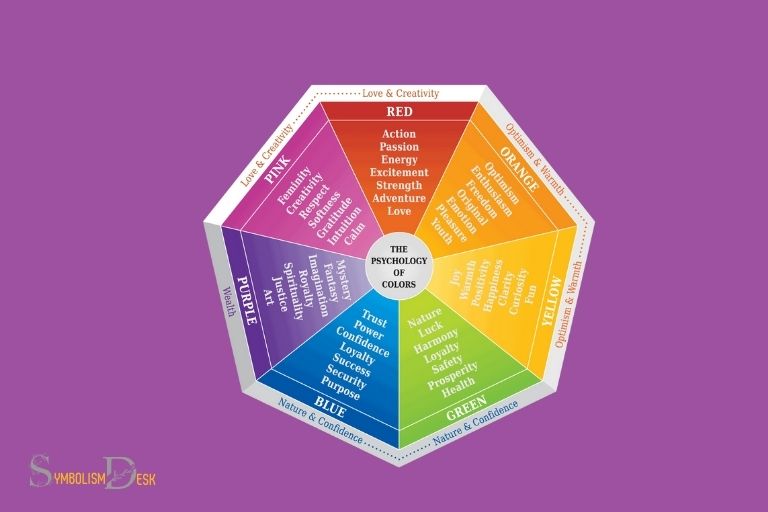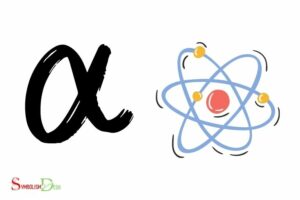Color Symbolism Chart With Meaning: Associations!
A color symbolism chart is a key reference tool that identifies and explains the various meanings, associations, and symbolic interpretations of different colors in various cultures and contexts around the world.
Symbolism in colors refers to the use of color to signify and represent deeper, abstract concepts or ideas.
Colors have long been used to convey messages without using words. These can vary greatly depending on cultural and individual interpretations.
For instance, while red can symbolize love and passion in some contexts, it could also signify danger or warning in others.
The interpretations of colors can greatly vary from culture to culture and individual to individual.
For example, while red often represents danger or warning signs in Western cultures, it is considered a symbol of luck and prosperity in Chinese culture.
Cultural context and personal experience significantly influence how one perceives and interprets color symbolism.
11 Colors Symbolism Chart with Meanings
| Color | Symbolism | Meaning |
|---|---|---|
| Red | Passion, Love, Anger | Indicates strong emotions, warnings or danger |
| Blue | Calm, Stability, Trust | Represents peace, tranquility and reliability |
| Yellow | Happiness, Energy, Caution | Conveys warmth, brightness and alert |
| Green | Nature, Fertility, Luck | Symbolizes growth, renewal and prosperity |
| Black | Power, Elegance, Mystery | Stands for authority, elegance and secrecy |
| White | Purity, Innocity, Simplicity | Represents purity, cleanliness and simplicity |
| Purple | Royalty, Luxury, Ambition | Conveys wealth, extravagance and creativity |
| Orange | Enthusiasm, Creativity, Determination | Represents excitement, fascination and stimulation |
| Pink | Romance, Love, Kindness | Indicates gentleness, femininity and health |
| Brown | Stability, Reliability, Comfort | Symbolizes strength, reliability and comfort |
| Grey | Neutrality, Balance | Stands for sophistication, practicality and timelessness |
Key Takeaway

Five Facts About: Color Symbolism and its Meanings
The Psychology Behind Color Symbolism
Color symbolism is an intriguing topic that has been studied for centuries. The colors we see around us have different meanings, and they can have a significant impact on our behavior and emotions.
How Colors Affect Us Emotionally And Mentally
Colors have a profound effect on our emotions and can significantly impact our mood. Our brain has an automatic reaction to different colors, whether it be calming, energizing, or stimulating.
Here are some of the emotions and behaviors that are associated with different colors:
- Red: It is known to be the color of passion and excitement. It increases heart rate and creates a sense of urgency. In marketing, it is used to attract attention and increase sales.
- Blue: It is a calming color often associated with trust, security, and reliability. Corporations use blue to create an image of professionalism and trust.
- Green: It is related to nature and creates a sense of calmness and freshness. It has a positive impact on feelings associated with growth, harmony, and balance.
- Yellow: It is an energetic color that evokes feelings of happiness and warmth. It is considered a high-arousal color that can increase attention and boost creativity.
The Meaning Of Colors In Different Cultures And Contexts
Colors can have different meanings depending on the culture and context. While red is the color of passion and excitement in western cultures, it is considered a symbol of good luck and fortune in eastern cultures.
Here are some of the ways in which colors are interpreted differently around the world:
- White: In western cultures, white is associated with purity and cleanliness, while in some eastern cultures, white is related to mourning and death.
- Black: It stands for power, sophistication, and elegance in the west, but it is also associated with mourning and sadness in many cultures.
- Purple: It is the color of royalty and luxury in the west, but it is related to death and mourning in some cultures in south america.
The Science Behind Color Symbolism And Its Impact On Human Behavior
Color psychology is a field of study that explores how colors impact human behavior and perception.
Research has shown that colors can affect various aspects of our lives, including decision-making, performance, and even our sense of time.
Here are some examples:
- The color of the walls in a classroom can impact student performance and behavior.
- Hospitals use calming colors to help reduce anxiety and stress among patients and their families.
- Restaurants use colors to influence appetite and perception of food quality.
Color symbolism is more than just an aesthetic choice. It has a profound effect on our behavior, emotions, and perceptions.
It is important to consider cultural context and color psychology when making any color-related decisions.
Understanding Color Symbolism Chart: A Comprehensive Guide
Colors play a significant role in our lives, and their significance varies based on cultural, personal, and situational factors.
Color symbolism chart is a tool that helps to understand the meaning and significance behind colors, based on various contexts, beliefs, and emotions.
Whether you are a designer, marketer, writer, or artist, understanding this chart can be incredibly beneficial.
Explanation Of Color Symbolism Chart
The color symbolism chart is a visual representation of colors and their meanings. It is a tool that provides insights into different aspects of colors such as emotional, psychological, cultural, and physical characteristics, among others.
While the meanings of colors can vary based on cultural or personal beliefs, some common associations are universal.
Here are some points to understand the color chart:
- The chart usually displays colors and their meanings, such as red for passion, love, and danger; blue for calmness, trust, and loyalty; green for nature, growth, and health.
- The chart might categorize colors based on themes such as warm colors, cool colors, bright colors, neutral colors, primary colors, and secondary colors.
- The chart might use symbols or graphics to represent a color’s meaning. For instance, red might be represented by a heart symbol to denote love and passion.
How To Interpret The Color Symbolism Chart For Different Purposes
Interpreting the color symbolism chart requires an understanding of the context and purpose.
Here are some points to keep in mind:
For branding and design purposes, understanding a color’s meaning based on consumer perception and cultural beliefs is crucial.
For instance, red color can represent passion and love but can also signify danger, depending on the context.
Hence, a brand must choose a color that aligns with its values and communicates the intended message to its audience.In literature and art, color symbolism can add depth and meaning to visual or written works.
For instance, the use of yellow color in literature can represent cowardice, while in contemporary art, it can represent hope and optimism.
In psychology, color symbolism can be used to study the relationship between colors and emotions.
It can help individuals recognize emotions and regulate them. For instance, blue color can be used in a therapy session to induce calmness and relaxation.
Examples Of Color Symbolism Charts And What They Represent
Here are some examples of popular color symbolism charts and their meaning:
Chakras: The seven chakras in our body are represented by different colors,
such as red for the root chakra, orange for the sacral chakra, yellow for the solar plexus chakra, green for the heart chakra, blue for the throat chakra, indigo for the third eye chakra, and violet for the crown chakra.
Traffic lights: Traffic lights use three colors to communicate different signals to drivers, such as red for stop, yellow for caution, and green for go.
Mood rings: Mood rings use different colors to represent different moods, such as blue for calm, green for average, yellow for tense, and black for stressed.
Aura colors: The aura represents the energy field around a person, and different colors represent different emotions and characteristics,
such as red for passion, orange for vitality, yellow for joy, green for harmony, blue for calmness, indigo for intuition, and purple for spirituality.
The color symbolism chart is a valuable tool that provides insights into the meaning and significance behind colors. Interpreting this chart requires an understanding of the context and purpose. Understanding genetic symbols is crucial to accurately interpret the significance of colors in different cultures and traditions. For example, while white may symbolize purity and innocence in Western cultures, it may represent mourning and sadness in some Asian cultures. This demonstrates the importance of understanding genetic symbols in order to grasp the full range of meaning behind colors.
By using the color symbolism chart, individuals can enhance their creativity, express emotions, and communicate their message effectively.
How To Choose The Right Colors For Your Brand
Color symbolism plays a significant role in branding and marketing. It can either make or break the overall appeal of a brand.
Choosing the appropriate colors for your brand is critical to communicate the intended message and evoke the desired emotional response.
Here’s a guide to help you pick the right colors for your brand using color symbolism.
Importance Of Picking The Right Colors For Your Brand
Choosing the correct color palette for your brand is a fundamental aspect of creating brand identity. Colors can help communicate what your brand stands for, establish recognition, and create a lasting impression.
Choosing the right colors for your brand will give it an edge over its competitors, making it easier for your audience to remember and recognize it.
Here are some benefits of picking the right colors for your brand:
- It makes your brand visually attractive and memorable
- It helps establish an emotional connection with your audience
- It sets your brand apart from your competitors
- It reinforces your brand identity and values
The Meaning Of Different Colors In Branding And Marketing
Colors have specific meanings in branding and marketing, and it’s essential to understand them before choosing the right colors for your brand.
Here’s a list of colors and their meanings:
- Red: Excitement, passion, love, anger, and danger
- Orange: Energy, creativity, warmth, and enthusiasm
- Yellow: Joy, positivity, optimism, and happiness
- Green: Nature, growth, health, and wealth
- Blue: Trust, professionalism, serenity, and calm
- Purple: Royalty, luxury, and ambition
- Pink: Femininity, love, and friendship
- Black: Power, elegance, and sophistication
- White: Purity, cleanliness, and simplicity
Tips For Choosing Colors That Resonate With Your Target Audience
Choosing the right colors that resonate with your audience can be challenging.
Here are some tips to help you select the appropriate color scheme for your brand:
- Understand your audience’s demographics and preferences
- Research your competitors’ color schemes
- Consider the emotional response you want your brand to evoke
- Limit your color palette to two or three colors
- Test your color scheme before launching it
Including Color Psychology In Branding Strategies
Color psychology is the study of colors’ impact on human behavior, emotions, and decision-making processes. By using color psychology, you can create a strong brand identity that resonates with your audience.
Here are some ways to include color psychology in your branding strategies:
- Choose colors that align with your brand’s values and personality
- Consider the cultural significance of colors in your target market
- Use color psychology to influence purchasing decisions
- Use appropriate color combinations to attract attention and evoke the desired emotions
Choosing the right colors for your brand is essential to create a lasting impression and establish brand identity.
Understanding the meanings of different colors and incorporating color psychology in your branding strategies can help you connect with your audience and make your brand stand out from the competition.
Real-Life Applications Of Color Symbolism
Color symbolism is a prominent feature in our daily lives. It affects our moods, influences our decision-making process, and even plays a significant role in branding and marketing.
Case Studies Of Successful Branding And Marketing Campaigns Using Color Symbolism
Color symbolism can be a powerful tool for brands to communicate their message to their target audience.
Here are some examples of successful branding and marketing campaigns that effectively use color symbolism:
Coca-cola: Coca-cola’s iconic red and white logo is instantly recognizable worldwide. The use of red represents passion, excitement, and energy, while the white symbolizes purity and happiness.
This combination of colors has helped to create a strong emotional connection between coca-cola and its consumers.
Mcdonald’s: Mcdonald’s famous golden arches use the color yellow, which represents happiness, positivity, and confidence.
Yellow also stimulates the appetite, making it the perfect color for a fast-food restaurant.
Apple: Apple’s sleek and modern design features a minimalist logo that uses the color white. White symbolizes simplicity, elegance, and cleanliness, which reflects the brand’s commitment to simplicity and user-friendly design.
Ways To Incorporate Color Symbolism In Daily Life
Color symbolism is not just limited to branding and marketing; it can also be used in our daily lives to express ourselves and create a certain atmosphere.
Here are some ways to incorporate color symbolism in daily life:
- Home decor: Paint your living room or bedroom walls with colors that represent the mood you want to create. For example, blue represents calmness, while red represents passion and energy.
- Fashion: Dress in colors that represent the mood you want to convey. For example, if you want to exude confidence and authority, wear black or navy blue, while if you want to feel upbeat and cheerful, wear bright colors like yellow or orange.
- Personal branding: Use colors that represent your personality and values. For example, green represents growth and harmony, while purple represents creativity and luxury.
Examples Of Color Symbolism In Popular Culture And Entertainment
Color symbolism is prevalent in popular culture and entertainment, including movies, tv shows, and music.
Here are some examples of color symbolism in popular culture and entertainment:
- The color red is often used to represent danger and passion in movies, such as the red light districts in tokyo or the red lights used during high-speed chases.
- In the tv show breaking bad, the use of the color green symbolizes greed, jealousy, and corruption, which reflects the characters’ moral decay throughout the series.
- The music video for taylor swift’s “blank space” uses black and white to symbolize the duality of the protagonist’s personality, highlighting her mysterious and dangerous side.
Color symbolism is a powerful tool that can be used in various aspects of our lives. By understanding its meaning and the emotions it represents, we can create the atmosphere and mood we desire.
Moreover, by incorporating color symbolism into branding and marketing strategies, brands can convey their message effectively and create a lasting emotional connection with their customers.
FAQ About on Color Symbolism Chart With Meaning
What Is Color Symbolism?
Color symbolism assigns meanings to colors for representation or communication purposes.
What Are The Most Common Colors And Their Meanings?
Red represents love or anger, blue conveys trust or sadness, green symbolizes growth and envy, yellow expresses happiness, and purple signifies royalty or spirituality.
How Do Cultural Differences Affect Color Symbolism?
Different cultures assign different meanings to colors. For example, while white represents purity in western cultures, it signifies mourning in some asian cultures.
How Is Color Symbolism Used In Branding?
Brands use color symbolism to evoke emotions and convey their message. For example, blue is commonly used by tech companies to inspire trust while red is used by fast-food chains to stimulate appetite.
Can Color Symbolism Affect Our Emotions?
Yes, colors can affect our mood and emotions. Warm colors like red, yellow, and orange can be energizing and exciting, while cooler colors like blue and green can be calming and soothing.
Conclusion
As we have learned in the course of this article, colors play an integral role in our emotions, thoughts, and perceptions.
Every color has a distinct meaning and it is important to know what messages we are sending when we use them.
The color symbolism chart we have shared will serve as a guide in understanding the meaning behind each color and how it can impact our daily lives.
Whether it’s in marketing, advertising, interior design, or personal expression, knowing how to use colors appropriately can greatly enhance our understanding and interpretation of the world around us.
So, the next time you choose to wear a specific color or design a marketing campaign, consider the meanings behind each color, and make an informed and impactful decision.
With a little knowledge and understanding, you can harness the power of color symbolism to your advantage and create a world that is both visually pleasing and meaningful.






